Armida (1771)
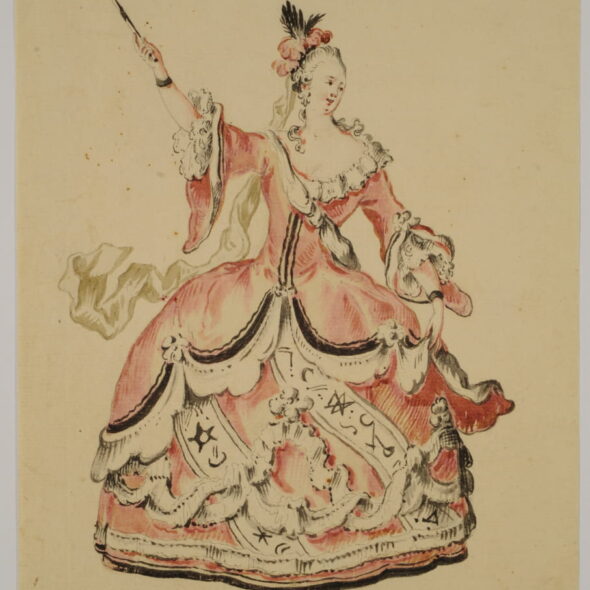
Synopsis
The sorceress Armida, queen of Damascus, uses her magic powers to defend Jerusalem against the Crusaders. She beguiles the “most valiant” knight, Rinaldo, and transports him to her enchanted island. Having fallen desperately in love with her captive, she is afraid of losing him.
Ubaldo, Rinaldo’s companion and fellow Crusader, has set out in search of him, with the aim of setting him free and bringing him back to take part in the siege of Jerusalem led by Godefroy de Bouillon. The overture describes Ubaldo’s arrival on the shores of Armida’s island, then his struggle against the demons defending it, finally putting them to flight with his magic shield. He comes to a delightful park – “un parco delizioso” – in which stands the sorceress’s palace.
Act I
Beautiful young women, dancing, sing of the transience of youthful beauty. The singing and dancing are interrupted by the arrival of Ismene, Armida’s confidante, who warns them that an unknown vessel has come to the island and the monsters guarding it have been defeated. All are alarmed, but when Ubaldo appears they hide their fear and urge him to lay down his arms and join in their pleasures. He rejects their welcome and Ismene summons demons to punish him, but the knight puts them to flight with the aid of his magic shield. Thanking Providence, he meditates on Rinaldo’s fate and prays for help in bringing him back to his senses.
Act II
In Armida’s enchanted pleasure gardens, she and Rinaldo celebrate their love. Armida fears they may be parted. Wishing to test the powers of her magic, she leaves. Alone, Rinaldo declares once again that he cannot live without her; in her absence, he wishes to see her image in his dreams. Ubaldo arrives. Seeing Rinaldo asleep, he ties his magic shield to a nearby tree. When Rinaldo awakens, he sees himself reflected in the shield and remembers who he is. Unaware of the shield’s magic powers, he is surprised when Armida runs away at the sight of it. He is about to go after her when Ubaldo returns and reminds him of hisduties as a Christian; he decides to return to the Crusade.
Act III
Armida still fears the magic shield. In “a subterranean chamber used for magic spells”, in the presence of her acolytes, she appeals in vain to the infernal gods. Interrupting the proceedings, Ismene arrives to tell her that Rinaldo has been set free and is about to leave the island with Ubaldo. To her followers’ astonishment, Armida resorts to tears in an attempt to make Rinaldo change his mind. Though freed from the spell and no longer lovesick, Rinaldo is still reluctant to abandon her; Ubaldo reproaches him for this. The arrival of Armida, who beseeches him to stay or else kill her, is the Crusader’s a final test. Unable to move Rinaldo by her grief, Armida faints. On regaining consciousness, she finds that Rinaldo has left. She laments her fate, orders the destruction of the island, then, climbing into a chariot drawn by winged dragons, leaves, swearing revenge.
Emmanuelle and Jérôme Pesqué
Translation: Mary Pardoe
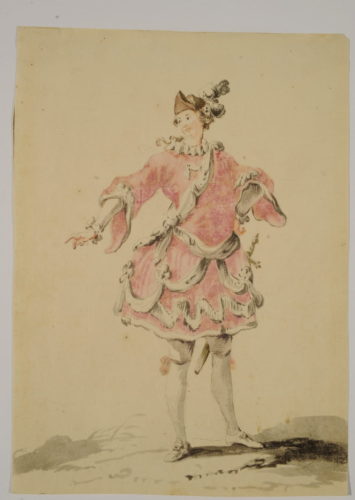
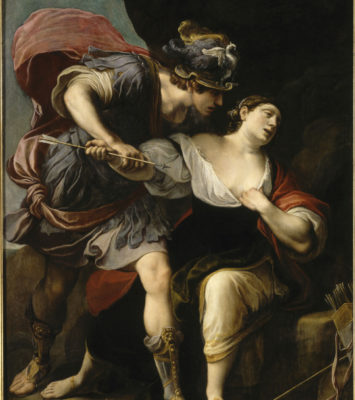
Tasso’s Jerusalem Delivered
The epic poem Gerusalemme liberata, written by Torquato Tasso between 1571 and 1580, the year of its first publication in Venice, has inspired many operatic works. One of its most popular episodes tells of the love between the Crusader Rinaldo and the Saracen sorceress and deposed queen of Damascus, Armida. This story has provided the basis for more than two hundred operas, as well as many literary adaptations and paintings, and a few ballets and films. The subject lent itself to sumptuous staging, and music and dance that captivated an audience forever eager to hear new variations on a theme that in the seventeenth and eighteenth centuries had become iconic for theatre-goers. In addition to its immediate appeal and the transgressive aspect of a love affair between a Christian Crusader and a Saracen sorceress, the story found an immediate echo in Vienna, which twice in the past (in 1529 and 1683) had been besieged by the Ottomans. After 1733 and Antonio Caldara’s version of the story, half a dozen operas on that theme were performed in Vienna.
The Viennese context
It was not the first time an opera inspired by Gerusalemme liberata had been presented in Vienna. Ten years earlier, in 1761, Traetta’s Armida, a one-act azione teatrale, to a libretto derived from Quinault’s text for Lully’s Armide (1686), had been given as part of the celebrations for the wedding of Emperor Joseph II to Isabella of Bourbon-Parma, and for the Habsburg-Bourbon alliance represented by that wedding, intended to bolster the First Treaty of Versailles (1756), signed by France and Austria. These performances, preceding those of Gluck’s Orfeo ed Euridice (1762), show the importance of French theatre in Viennese musical and theatrical life at that time, and the rise of the so-called “reform” arts during the dynastic alliances that structured European politics.
Armida, a dramma per musica written when Salieri was twenty years old, was his first opera seria, representing a milestone in his musical career. Le donne letterate (The Learned Ladies) of 1770, an opera buffa written with the encouragement of Giuseppe Scarlatti and Gluck, had been his first full opera. With Armida he was able to show what he had learned from the teachings of Florian Leopold Gassmann (1729-1774) and from the example of Gluck, while at the same time expressing his own personality.
Between 1766 and 1776 the court theatres in Vienna were managed under contract by impresarios who, although nominally independent, were subject to the court’s approval or veto in almost everything they did, and it was the court that subsidised many if not all the works presented. Since opere buffe were less costly to produce, the impresarios gave such works a prominent place in the repertoire, which is why it is surprising that Salieri was commissioned at that time to compose a serious work in Italian. Indeed, an opera requiring dancers, a chorus, sumptuous sets and lavish staging was a risky investment, to say nothing of the fact that, although the emperor had already noticed his talents, the young composer was inexperienced in the genre. All such operas presented in Vienna between 1767 and 1770 had celebrated special occasions at court, and most of them had therefore received the court’s financial support. Armida, however, does not appear to have been commissioned for such an occasion, nor does any documentary evidence link the court to this opera. A clue, however, may lie in the fact that the soprano Catharina Schindler, who took the title role, and the Italian soprano castrato Giuseppe Millico (Rinaldo) had previously taken part in three works by Gluck, Orfeo ed Euridice, Paride e Elena and Alceste, that had been presented at the court theatres in 1770 and 1771. These singers were probably engaged, on the emperor’s suggestion, by the impresario Johann Kohary, who ran the court theatres from 1770 to 1772, and their presence no doubt had a significant bearing on Salieri’s composition of a serious “reform” opera. The first Armida was praised for her “pleasant, pure, bright voice in the higher notes” and her “lively and expressive acting”, while her Rinaldo, according to a critic who witnessed the performances in Vienna, was “an outstanding singer”, whose “greatest strength lies especially in the type of singing that requires expression; there he knows how to give the strongest emphasis to each emotion.” The role of Ubaldo may have been created by the buffo caricato Francesco Bussani, who sang both tenor and bass roles, and was later to sing Bartolo and Don Alfonso for Mozart.
Salieri, who is believed to have played the harpsichord at the Viennese première of Alceste in 1767, was in a good position to become familiarised with Gluck and his reform of serious opera, as exemplified by Orfeo ed Euridice (1762), Alceste (1767) and Paride ed Elena(1770). Armida, which he placed in the “ magico-heroico-lyrical style, touching the tragic” (“stile magico-eroico-amoroso toccante il tragico”), clearly followed in Gluck’s footsteps and was the first opera by another composer to embrace his reform.
An auspicious beginning
Armida was premièred at the Burgtheater in Vienna on 2 June 1771. The following day, Joseph II wrote to his brother, Grand Duke Leopold of Tuscany (later Leopold II): “Yesterday a new opera, Armida, was performed for the first time; the music is by Salieri, Gassmann’s student. It was very successful; I will send it to you.”[sic] A critic described it as “exceptionally successful”, delighting the audience. Count Carl von Zinzendorf, a keen concert- and theatregoer, wrote in his diary (2 June 1771): “To the opera for Armide [sic]; it is beautiful, not only the spectacle, but also the scenery and the music”. A set of seven costume designs in watercolour, formerly believed to be for Haydn’s Armida, premièred at the Esterháza court theatre in 1784, have now been identified as pertaining to a production of Salieri’s version, either the première in Vienna or a revival elsewhere in Europe; they show how rich the costumes were.
Since Catharina Schindler and Giuseppe Millico left Vienna at the end of October 1771, it is unlikely that Armida was performed there after that. But it was subsequently received with enthusiasm in Copenhagen (1773), Saint Petersburg (1774) and in northern Germany (several productions between 1776 and 1785). In Hamburg, the distinguished poet and critic Heinrich von Gerstenberg (1737-1827) was delighted by Salieri’s music; in a letter to his wife dated 15 April 1776, he wrote: “Divine! I shed tears ten times; it was too strong for me.”
The work’s success led to the publication by Carl Friedrich Cramer (1752-1807) of the libretto translated into German and a keyboard-vocal reduction (Leipzig, 1783): Armida was one of the very few operas published in Germany in the eighteenth century. In a letter to Cramer dated 20 July 1784, Salieri, ever dissatisfied, confessed: “[…] the only thing I love in vocal music is truth, that truth which the incomparable Gluck makes me feel so profoundly throughout and in every detail of his Tragedies […]; so I strive to bring truth to all those of my operas which deserve such care – this is the only reason for the changes I have made, and continue to make, to the score of Armida.” Thus we learn that Salieri made some later adjustments to his score.
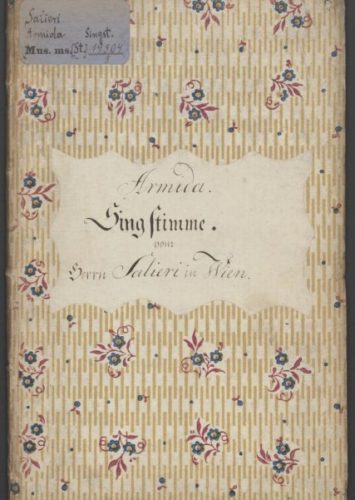
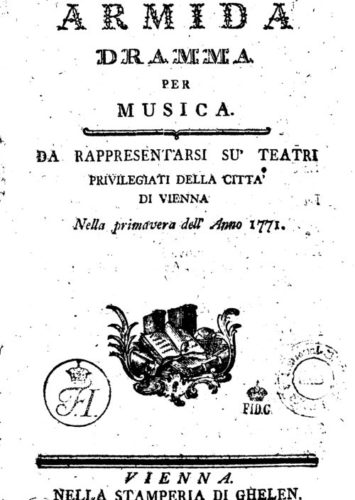
A libretto between the dramatic and the marvellous
Marco Coltellini (1719-1777), the house poet for the imperial theatres from 1766 to 1772, collaborated only once with Salieri on an opera seria, a genre for which he felt much more affinity than for opera buffa recently introduced in Vienna. Long before Calzabigi’s Alceste, set by Gluck, Coltellini had introduced choruses, ballets, vocal ensembles and, in general, greater complexity into his opere serie, which were performed in Vienna between 1763 and 1768. Calzabigi, furthermore, regarded Coltellini as his artistic successor.
His libretto for Armida is characterised by a condensed plot, sustained in its dramatic intensity. Its three short acts, much shorter than those of the traditional dramma per musica, focus on just four characters, rather six or seven as in the operas of Metastasio. Thus, he omitted some of the traditional twists and turns of the plot in order to concentrate on the two lovers (Armida and Rinaldo, two soprano roles), the disrupting agent in their idyll, (Ubaldo, baritone, appearing here without his usual companion, the Danish knight; in notating this role, Salieri used both tenor and bass clefs), and finally Armida’s confidante (Ismene, soprano; a character that does not exist in Tasso’s narration of the story; Ismene is an avatar of the Muslim sorcerer Ismeno, who does appear elsewhere in the epic poem). The previous version of this text, written for Giuseppe Scarlatti in 1766, and probably never set by him, had been stripped down even further to focus on just three characters, Armida, Rinaldo and Ubaldo. Framing a second act that concentrates on the emotions of the two lovers, Acts I and III give prominence to the supernatural and the marvellous, using a language that is intentionally simple, but which includes references here and there to Tasso’s poem. Judging by Coltellini’s very detailed stage directions, the scenic effects must have been impressive.
Salieri’s music – a protean opera
The ambition and scope of the work are already clear from the overture. This is not a simple sinfonia intended to introduce the subject, but a programmatic score directly relating to the action, following the precepts set forth by Gluck in the preface of Alceste, published two years earlier, in 1769. In the extensive annotations found in the manuscript score, Salieri states: “My reading of the cantos of Gerusalemme liberate of Tasso concerning Rinaldo on the island of Armida gave me the idea of composing, as the overture to this opera, a kind of pantomime as prelude, a pantomime performed by the orchestra alone, but which the public, informed beforehand by the libretto, listened to attentively for many evenings, and applauded as a novelty that did great honour to the young composer.” The explanatory note included in the libretto tells us that the sinfonia evokes “what happened in the drama immediately before the beginning of the action; namely the arrival of Ubaldo on Armida’s island, enshrouded in a dense, dark fog; the guardian monsters that hurl themselves upon him from above in an attempt to terrify him; the horrible shrieks and the confusion in which they are put to flight by Ubaldo as he simply reveals the magic shield; the difficulty of the painful ascent up the mountain’s rugged cliff; and the rapid passage at the peak to a delightful, peaceful serenity.”
Salieri combined the melodic richness of Italian opera with the dramatic framework of the French tragédie lyrique. Thus, choruses and dances play an essential part in Armida, moving it away from the structure of the Metastasian opera seria, and lending it a dramatic and musical fluidity, one might say a through-composed form. The former strict alternation of aria and recitative gives way here to a flowing score, closely following the action as it unfolds, with the choruses coming in at several points to highlight and support the solos (see Acts I and III). Similarly, the choruses often accompany the ballets, choreographed in the first production by the great French dancer, choreographer and ballet master Jean-Georges Noverre (1727-1810), who was also famed as a dance-theorist for his ideas on the “ballet d’action”.
Of course, the importance given to the two principal soloists is still very marked. But while pure virtuosity seems to be a concession to the celebrated artists who took the leading parts, the coloraturas here have a dramatic rather than a purely hedonistic role, as the scenes for Armida and Rinaldo show. Salieri also makes wide use of accompanied recitative to dramatize the discourse, and create, by means of invisible transitions, a continuous tension. Although Salieri had not yet reached the height of his creative powers in this early work, he nevertheless shows already a constant concern for dramatic expression, variety in his use of colour and effect, and efficiency in the narrative. Thus he does not hesitate to introduce typically opera buffa effects, and this was noted and admired by his contemporaries. His understanding of voices (he was later to be greatly in demand as a teacher) and his readiness to incorporate the most diverse stylistic elements made for a very colourful score, ideal for this tale of enchantment and heroic endeavour.
With his first opera seria, Salieri thus prefigured what Gluck was to do later with his Armide of 1777. The plasticity of his composition, the originality and brio he shows in this avant-garde style, were to ensure his lasting reputation and earn him, much later, his first commission from the Académie Royale de Musique in Paris. His three French operas, Les Danaïdes (1784), Les Horaces(1786) and Tarare (1787) are therefore the later scions of this first great success. Armida’s revival now in France enables us to hear at last the very beginnings of an operatic œuvre that was to be performed successfully all over Europe.
Emmanuelle and Jérôme Pesqué
Translation: Mary Pardoe
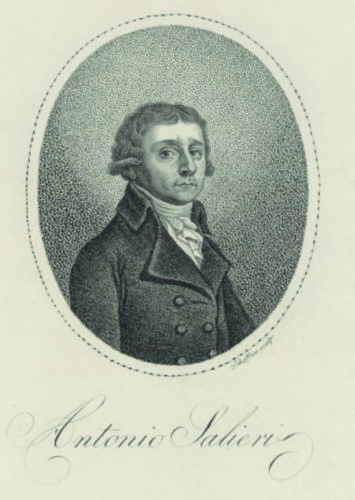
Partitions, livret et orchestration
Sources
Score :
- Manuscript score (1771): Vienna, Österreichische Nationalbibliothek, Manuscrit Mus. Hs. 17837. This source corresponds to the piece’s first version.
- Manuscript score (1790): Staatsbibliothek zu Berlin, Mus. Ms. 19304. This source corresponds to the viennese source (Mus. Hs. 17837) but in german.
- Retrievable online here.
- Part-sets (1790): Staatsbibliothek zu Berlin, Mus. Ms. 19304/3. Vocal parts and orchestral scores which correspond to the Manuscript score’s part-sets (Berlin, Mus. Ms. 19304).
- Retrievable online here.
- Manuscript autograph score (1820): Vienna, Österreichische Nationalbibliothek, Ms. 16517. This score has been modified many times by Salieri and corresponds to a later version.
- Reduced score for keyboard (1783) : Munich, Bayerishe StaatsBibliothek, piano-vocal version in Italian and German, published by Carl Friedrich Cramer (1752-1807) from Breitkopf in Leipzig.
- Retrievable online here
Booklet :
- Italian booklet (1771) : Vienna, Österreichische Nationalbibliothek, 641432-A.9,4 / MUS MAG. Premiere’s booklet.
- Retrievable online here
- French booklet : ttranslated by Deville, published in Saint-Petersburg in 1774. It complies with the Italian version of 1771.
- Retrievable online here
Modern edition
Les Talens Lyriques uses its own edition (score and material), burned by Nicolas Sceaux from the Viennese source of the Premiere (Austrian National Library, Manuscrit Mus. Hs. 17837). This edition will be free shared on the IMSLP platform and Nicolas Sceaux’s website: http://nicolas.sceaux.free.fr/.
For further information
- Volkmar Braunbehrens, Salieri, dans l’ombre de Mozart. (Translation by Marie Hélène Ricquier). Jean-Claude Lattès, 1989.
- Caryl Clark, « Fabricating Magic: Costuming Salieri’s “Armida”» in Early Music, Vol. 31, N° 3 (Aug. 2003), p. 451-461.
- Vittorio Della Croce, Francesco Blanchetti, Il Caso Salieri. Eda, 2001.
- John A. Rice, Emperor and impresario: Leopold II and the transformation of Viennese musical theater, 1790-1792. Doctoral thesis, University of California, 1987.
- John A. Rice, Antonio Salieri and Viennese Opera. The University of Chicago Press, 1998.
- John A. Rice, « Armida (dramma per musica by Salieri) » in Grove Music Online (1992).